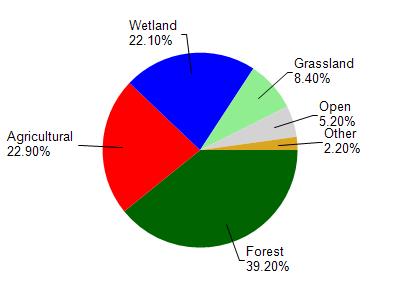Chippewa
No
No
No
Fish and Aquatic Life
Overview
Bob Lake is a good quality lake with relatively little development along its shoreline. The lake is,
however, threatened by increasing development. It is important to water quality as
development occurs. Shoreline development will result in increased surface runoff and nutrient
loading to the waterbody, unless storm water runoff is controlled and effective erosion control
measures are implemented as development occurs.
Date 1996
Author Aquatic Biologist
Historical Description
Source: 1963, Surface Water Resources of Chippewa County Bob Lake T31N, R8W, Sections 13, 14, 23, and 24
A soft water, drainage lake on Bob Creek, (North Fork). It is managed for northern pike, largemouth bass, and pan fish. Walleyes are also present. About 90 acres of wetlands provide habitat for beaver and nesting mallards, teal, wood ducks and mergansers. Additional numbers of migratory waterfowl use the lake in spring and fall. Its public frontage consists of a 60-foot access with a limited parking area and 1, 478 feet (. 29 miles total public frontage) of County Forest Cropland frontage. It has one resort, one boat rental place and nine cottages.
Surface Acres = 96.6, S.D.F. = 1.39, Maximum Depth = 72 feet
Date 1963
Author Surface Water Inventory Of Wisconsin
Condition
Wisconsin has over 84,000 miles of streams, 15,000 lakes and milllions of acres of wetlands. Assessing the condition of this vast amount of water is challenging. The state's water monitoring program uses a media-based, cross-program approach to analyze water condition. An updated monitoring strategy (2015-2020) is now available. Compliance with Clean Water Act fishable, swimmable standards are located in the Executive Summary of Water Condition in 2018. See also the 'monitoring and projects' tab.
Reports
Management Goals
Wisconsin's Water Quality Standards provide qualitative and quantitative goals for waters that are protective of Fishable, Swimmable conditions [Learn more]. Waters that do not meet water quality standards are considered impaired and restoration actions are planned and carried out until the water is once again fishable and swimmable
Management goals can include creation or implementation of a Total Maximum Daily Load analysis, a Nine Key Element Plan, or other restoration work, education and outreach and more. If specific recommendations exist for this water, they will be displayed below online.
Monitoring
Monitoring the condition of a river, stream, or lake includes gathering physical, chemical, biological, and habitat data. Comprehensive studies often gather all these parameters in great detail, while lighter assessment events will involve sampling physical, chemical and biological data such as macroinvertebrates. Aquatic macroinvertebrates and fish communities integrate watershed or catchment condition, providing great insight into overall ecosystem health. Chemical and habitat parameters tell researchers more about human induced problems including contaminated runoff, point source dischargers, or habitat issues that foster or limit the potential of aquatic communities to thrive in a given area. Wisconsin's Water Monitoring Strategy was recenty updated.
Grants and Management Projects
| Project Name (Click for Details) | Year Started |
|---|
|
|
Monitoring Projects
| WBIC | Official Waterbody Name | Station ID | Station Name | Earliest Fieldwork Date | Latest Fieldwork Date | View Station | View Data |
|---|
| 2178400 | Bob Lake | 10001972 | Bob Lake | 8/29/2000 | 9/12/2017 | Map | Data |
| 2178400 | Bob Lake | 093057 | Bob Lake - Deep Hole | 2/28/1990 | 8/12/2025 | Map | Data |
| 2178400 | Bob Lake | 10018212 | Bob Lake -- Access | | | Map | Data |
|

Watershed Characteristics
Bob Lake is located in the McCann Creek and Fisher River watershed which is 311.06 mi². Land use in the watershed is primarily forest (39.20%), agricultural (22.90%) and a mix of wetland (22.10%) and other uses (15.80%). This watershed has 385.14 stream miles, 3,485.11 lake acres and 33,345.65 wetland acres.
Nonpoint Source Characteristics
This watershed is ranked Not Ranked for runoff impacts on streams, Not Ranked for runoff impacts on lakes and High for runoff impacts on groundwater and therefore has an overall rank of High. This value can be used in ranking the watershed or individual waterbodies for grant funding under state and county programs.This water is ranked High Lake for individual Lakes based on runoff problems and the likelihood of success from project implementation.